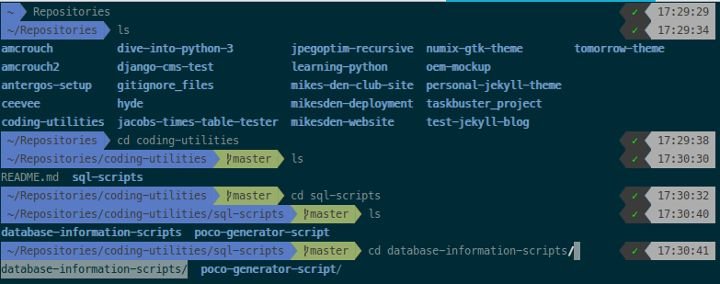Dotfiles and Zsh
28 March 2017
Photo: Andy Crouch
The trouble with getting older is the amount of baggage you accumulate.
I have worked across various Linux and Windows machines in the last 18 odd years. Since 2002 when I installed Slackware over the course of a weekend, I have rarely been without a terminal. For years I ran Cygwin when I was on a Windows machine. Recently I found Babun which is the best *nix environment on Windows. I will write more details on that soon.
When you use the terminal you tend to find little tweaks and changes start to creep into your rc and profile files. Over time and after installing many tools and frameworks, your files start to look tired. You find you have blocks commented out. Configurations for tools you have long abandoned and settings which make no sense. Over the years I have included tweaks for different machines and terminal variants. Most of these are no longer required.
So I have decided to prune and more or less start over with my dotfiles. I will be updating my setup and documenting it as I go here on the blog. I will also make my configuration available on GitHub once I have it working in a basic fashion.
I decided to look at how I use the terminal first.
Zsh
Bash has been my terminal of choice right up until about a year ago. I had created a great framework which allowed me to load shared configuration. Machine dependent configuration was sourced by host name. It worked well and meant that I stared at this prompt for about 15 years.

I had come across z shell (zsh) when installing Arch. I wasn’t really blown away, perhaps a little indifferent. Then I read an article (which I can no longer find) that sold me on switching to the z shell (zsh) based on the productivity gains.
Wikipedia describes zsh as:
Zsh is an extended Bourne shell with a large number of improvements, including some features of bash, ksh, and tcsh.
Benefits of zsh
I started to write a long parapgraph on the benefits of zsh. However, I came across this excellent slide deck (by Brendon Rapp) which covers many of the benefits of zsh much better than I can:
Setup and configuration
So I have switched full time to zsh. For Arch users, this link describes the process of switching your shell from Bash to zsh. The first time you fire zsh up it will walk you through a setup wizard. This will set up a default terminal experience. This is fine but what you want to do next is install the excellent oh-my-zsh framework.
oh-my-zsh contains hundreds of plugins and themes that make using zsh even better. Installation details can be found on the project page but it is as simple as
$ sh -c "$(curl -fsSL https://raw.githubusercontent.com/robbyrussell/oh-my-zsh/master/tools/install.sh)"The project page covers enabling plugins and setting themes so I will not rehash that here. For convenience, there are screenshots of most themes.
I saw a co-worker using powerline status bars in vim, tux and shell and decided to go for something similar. There is a simple powerline type theme in oh-my-zsh called agnoster. It was fine but I had read about Powerline 9K which I decided to try as it is more configurable. Full installation details are here for Powerline 9K. Powerline 9K is very configurable and allows you to configure segments within your prompt. There are segments already available for many programming environments and git.
 Welcome to my site and blog. You can find out about me and read my thoughts on code and technology, start-ups and building things.
Welcome to my site and blog. You can find out about me and read my thoughts on code and technology, start-ups and building things.